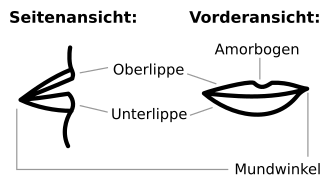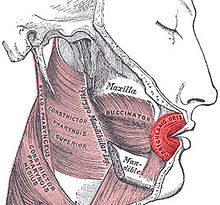lip
The lip ( lat. Labium, labia, labea, labrum, also labium oris "lip of the mouth") is an organ that always occurs in pairs on the mouth of humans and many animals (there often referred to as the lip ). The two lips are soft, bulging and very flexible and are primarily used for ingesting food and as a tactile organ for objects that have been picked up.
Anatomical foundations of the human lip
A distinction is made between the upper ( labium superius ) and lower lip ( labium inferius ), whereby the lower lip is usually slightly larger. The upper borderline of the red lip with the curved indentation in the middle is called Cupid's arch , also called cupid arch or lip heart . Often the only misunderstanding of the lips is the red color of the lips. The two lips delimit the mouth gap .
On the inside of both lips there is a small fold of the mucous membrane to the oral mucosa , the lip frenulum ( frenulum labii superioris or inferioris ). The fleshy basis of the lips is formed by the orbicularis oris muscle , the movements of the lips are supported by other parts of the facial muscles . Between Cupid's bow and nose lies the philtrum , a vertical depression in the form of a "groove" that can be of different depths. The philtrum meets the nasal bridge ( lat. Columella "small column") at the upper end and forms the nasolabial angle with it , which has an average width of 90–95 degrees in men and 100–105 degrees in women .
In humans, the skin of the lip is very thin with three to five cell layers compared to the up to 16 cell layers of the rest of the facial skin. For lighter skin color , the lip skin contains no melanocyte ( pigment - cells , the skin dark color). As a result, the blood of the underlying blood vessels shines through more strongly than in the rest of the facial skin and leads to a distinct red coloration of the lips. With darker skin color this effect is less noticeable, because here the skin of the lips is also interspersed with melanin and therefore optically denser .
The skin of the lips is not hairy and has no sweat - and only occasionally has sebum glands . This means that it does not have the hydro-lipid film that is usual for the rest of the human body's skin , a protective layer made of sweat and sebum that keeps the skin supple and kills pathogens . The skin on the lips therefore dries out faster and becomes brittle more easily .
The blood supply comes from the arteria labialis inferior (lower lip) and arteria labialis superior (upper lip), both of which arise from the facial artery .
Competent and incompetent lips
Orthodontists differentiate competent lips, which seal the mouth in a relaxed state, from incompetent lips, which do not or not completely close the mouth in a relaxed state. It is believed that incompetent lips have negative effects on the health of the teeth and jaws, as many activities - for example chewing - require above-average muscle tension to close the mouth; some more specific examples are described below.
Functions of the lip
Ingestion
The lips are very flexible due to their own muscle base and adjacent muscles of the face and are used when eating, to hold food or to convey it into the mouth . In addition, the lips serve to seal the mouth airtight and thus keep food and saliva inside or block out unwanted objects. By forming a narrow funnel with the lips, the suction power of the mouth is increased. This is essential when sucking food - for example when suckling - and also forms the functional principle of the drinking straw .
An incompetent lower lip, unlike a competent one, is always very tense when chewing; some medical professionals conclude that this could have negative effects on the chewing movement and thus also on jaw health.
Local anesthesia for treating teeth can, with a time delay, temporarily lead to numbness and functional weakness of the lips when rinsing the mouth with water.
Organ of touch
The lip has many nerve endings and, as part of the sense of touch, is very sensitive to touch, heat and cold. It is therefore an important tool for small children to examine unknown objects. The variety of sensory impressions conveyed is also evident when kissing .
A hair brush can be sharpened wet with the tongue and lips - possibly also with saliva . For fine painting, picking up gold leaves for gilding. Using this technology, radioactive luminous paint for clock faces causes tongue cancer.
In order to interrupt the path of infection, for example for Covid-19 , the embarrassed gesture should be avoided by putting fingers to the mouth.
Sound formation
The lips are used to form various sounds - mainly the labial , bilabial and labiodental phones - and thus form an important part of the human speech apparatus. Lip reading builds on the formation of sound with the lips , the recognition of spoken language solely by observing the speaker's lip movements. In addition, the lips allow whistling and playing wind instruments such as the trumpet and flute .
facial expressions
When expressing emotions through facial expressions , the lips occupy a prominent position as the visible border around the mouth. In many cases, the depiction of a pair of lips without a face is sufficient to guess the facial expression of a person: For example, raised corners of the mouth are usually a sign of joy , straight or pulled down corners of the mouth are a sign of sadness . This fact forms the basis of simple drawings by toddlers and pictograms such as smileys and emoticons . The whole range of possible facial expressions through lip position alone becomes clear in artistic forms such as portraits and comics and in psychological studies of emotions and body language .
gesture
Numerous gestures can be expressed with the lips and the mouth in interaction with fingers and hands:
- With the index finger held vertically and possibly the middle finger attached, on your own mouth or the mouth of the other person: Psst! Be still, silence.
- With the same two fingers held together at an angle on the mouth and an axial twisting movement in the forearm: smoking a cigarette. (Variation cigar: mouth slightly more open and fingers slightly open.)
- Closed, stretched four fingers of one hand in front of a fairly wide open mouth: yawning, fadesse.
- Fold down the lower lip repeatedly with the index or middle finger: Playful.
- Conceal the mouth area, or at least the lips, with a cupped hand: shame, hiding feelings.
- Representation of brushing teeth, applying lotion to lips, sucking thumbs, vomiting, oral sex.
- Showing feelings of fear or shyness.
- Kiss on the back of the hand, "kiss goodbye".
- Priests bring the great host to their lips.
Erogenous zone
The lips form an erogenous zone due to their high density of nerves . [R?] Hence, beautiful lips can increase a person's sexual attractiveness . Whether lips are beautiful depends not only on a symmetrical shape and a healthy appearance, but also on how full they are: the fuller the lips, the more beautiful they are perceived by many. The larger its vertical diameter , the fuller a lip is.
Symbolic meaning
Lips are often seen as a symbol of sensuality . There are many reasons for this, including the fact that, as organs of touch, they are particularly sensitive and pleasantly soft to the touch. In addition, they are part of the mouth and thus take over some of its symbolic connections (see e.g. oral phase of psychology according to Sigmund Freud ).
Changes in the lips
- One of the most common changes in the lips is the blue coloration in the context of cyanosis : the blood contains little oxygen and is therefore dark red to blue in color, which in turn shines through the thin skin. Cyanosis is the reason that corpses always have bluish lips. In the cold, cyanosis can occur even with slight hypothermia , so that pale or bluish lips are not uncommon, especially in winter.
- Lips can (temporarily) swell. The reasons are varied, ranging from violations of adverse side effects of drugs to misalignments of the teeth .
Hereditary features and malformations
The following characteristics are common or particularly well known:
- The Habsburg lower lip is a particularly pronounced lower lip caused by overdevelopment of the lower jaw . It is named after the Austrian dynasty of Habsburg , in which this hereditary trait was widespread.
- Alcohol embryopathy is caused by the mother's alcoholism in embryos . Typical malformations are a weakly or not at all pronounced philtrum ("little relief"), an even thinner lip skin than usual, retracted red lips and a weakly developed or nonexistent Cupid's bow.
- Cleft lip and palate
Diseases
As an organ of the body, the lip can also be a source of disease or show symptoms of a disease :
- Cold sores (more precisely herpes labialis , a subtype of herpes simplex ) is a viral disease that manifests itself in the formation of painful blisters on the lips.
- Carcinomas ( cancerous growths ) on the lips are mainly caused by tobacco consumption and excessive exposure to sunlight , also by poor oral hygiene , ill-fitting dentures and malformations of the teeth . Smoking tobacco pipes in particular is a risk factor due to the special form of puffing , but cigarettes and chewing tobacco can also lead to illness. Alcohol seems to increase the carcinogenic effects of tobacco use.
- In the slightly damp corner of the mouth, fungi or bacteria can settle and hurt the skin painfully.
Injuries
The following injuries to the lips often occur unintentionally or intentionally:
- Rhagades are tears in the skin. They can occur when the skin of the lips is less elastic than usual due to dryness, frost or diseases such as neurodermatitis .
- Due to its thinness, the skin of the lips is extremely sensitive and becomes easily brittle and cracked in frost; To counteract this, many people use fat- based skin creams or corresponding preparations ( lip balm ) when it is cold .
- Due to the thinness of the skin and the hard and sharp-edged rows of teeth behind it, the lip is also very sensitive to injury and bleeds heavily in the event of a cut or laceration .
- Some people chew their upper or lower lip when they are nervous or tense. They often injure themselves (consciously or unconsciously) on their oral mucosa.
- To avoid burning the lips on hot food or a hot drink, it is advisable to move the lips towards the object so slowly that the lips can detect the heat radiation or the rising warm air before touching them. Hot liquid can be mixed with the surface by briskly sucking in air above its surface and thus sucking in less heat transferring.
- Lips that have already cooled down and are damp with saliva can freeze on when they come into contact with deeply cold, highly conductive metal - for example when playfully touching an aluminum ski stick. There is then the risk of a piece of skin being torn off.
Plastic surgery
- Lip corrections are cosmetic operations and are intended to beautify the patient's body . In most cases, fat is taken from another region of the body and used to reshape the lips (autologous fat replenishment). This treatment method of lip splattering is often referred to as lip filleting.
Jewellery
- Coloring the lips with lipstick is supposed to highlight them optically.
- Labret piercings are piercings that are pierced through the lip and worn permanently as jewelry .
Lips in the animal kingdom

Lips are a typical feature of mammals (with the exception of the mammals , which have beaks ). Presumably, the lips were created through evolution in this class of animals , because they support and simplify suckling - the common feature of all mammals.
The lips fulfill very similar tasks in the animal kingdom as in humans: They mainly serve to take in food and as an organ of touch. The lips support facial expressions, especially in predators . For example, when dogs pull up their lips (lips) and bare their teeth ("baring teeth"), this can be part of a threatening gesture intended to scare off rivals. The lips usually play a subordinate role in the generation of sounds.
literature
- Otto Neustätter: About the lip seam in humans, its structure, its development and its meaning in: Jenaische Zeitschrift für Naturwissenschaft , Volume XXIX, 1894, OCLC 799040279 (Dissertation University of Munich 1895, 48 pages, illustrated).
Web links
Health related issues:
- ARD morning magazine: "Sun protection for the face" ( Memento from May 14, 2008 in the Internet Archive ) - information on sun protection for light skin color with emphasis on the lips
Lips in art:
- Theodor Storm: Your lips are disenchanted - poem by the German writer Theodor Storm
- Peter Kraus: Red lips should be kissed ( memento from November 24, 2004 in the Internet Archive ) - text and music of the well-known German hit



